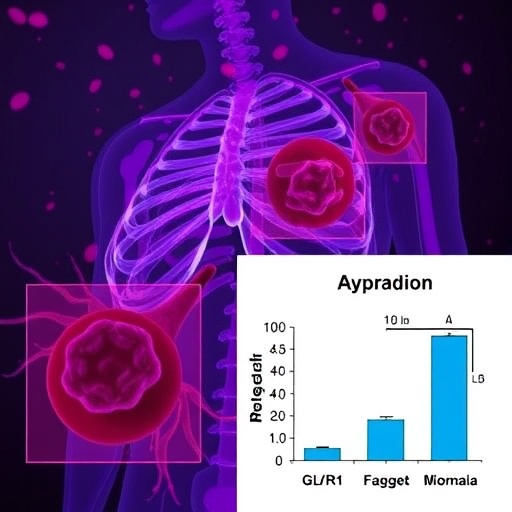A groundbreaking study published in Medical Oncology has unveiled a critical molecular axis influencing breast cancer progression, shining new light on therapeutic possibilities for this devastating disease. The research focuses on GLYR1, a lesser-known regulator protein, and its ability to suppress a long non-coding RNA (lncRNA) called HSD11B1-AS1, triggering enhanced cancer cell proliferation, migration, and invasion. This mechanistic insight emerges as a pivotal discovery with far-reaching implications for breast cancer biology and treatment strategies.
Breast cancer remains one of the leading causes of cancer-related death worldwide, predominantly due to its ability to metastasize and resist current therapies. Central to this challenge is a complex network of genetic and epigenetic modulators that alter cellular behavior. In this context, lncRNAs have received increasing attention; these RNA molecules, although not translated into proteins, modulate gene expression and cellular phenotypes in profound ways. The current study breaks new ground by implicating the downregulation of HSD11B1-AS1 as a driving force behind tumor aggressiveness.
The protein GLYR1, originally characterized for its role in chromatin remodeling and gene expression regulation, emerges in this research as a key upstream regulator. Researchers observed that GLYR1 mediates the suppression of HSD11B1-AS1, a lncRNA whose normal expression appears to restrain malignant behaviors in breast cells. Experimental data demonstrate that when GLYR1 activity is elevated, the consequent downregulation of HSD11B1-AS1 unleashes a cascade of cellular changes conducive to cancer spread.
Delving deeper into cellular mechanisms, the investigators revealed that decreased HSD11B1-AS1 expression diminishes the regulatory control over gene networks responsible for maintaining cellular adhesion and inhibiting motility. This loss translates into enhanced migratory and invasive capacities of breast cancer cells, hallmarks of metastatic potential. The shift in gene expression patterns emphasizes how lncRNAs, once considered “junk” RNA, have crucial roles in maintaining cellular homeostasis.
Functional assays corroborated these findings, illustrating that breast cancer cell lines subjected to GLYR1 overexpression exhibited accelerated rates of proliferation, going beyond mere survival to actively enhance tumor mass expansion. Concurrently, these cells demonstrated increased motility in wound healing and transwell migration experiments, affirming a phenotype poised for metastasis. This dual promotion of growth and dissemination underscores the dire consequences of the GLYR1-HSD11B1-AS1 axis imbalance.
Intersecting pathways further illuminate this regulatory network. The study highlights the involvement of critical signaling cascades, including the epithelial-mesenchymal transition (EMT), a process by which epithelial cells gain migratory and invasive properties. GLYR1-mediated downregulation of HSD11B1-AS1 instigates EMT marker expression, such as reduced E-cadherin and elevated N-cadherin and vimentin levels, facilitating cellular detachment and transit from the primary tumor site.
Importantly, patient-derived tissue samples revealed a negative correlation between GLYR1 and HSD11B1-AS1 expression levels, validating the clinical relevance of these molecular dynamics. Tumors exhibiting high GLYR1 and low HSD11B1-AS1 were associated with more aggressive phenotypes, poorer prognostic indicators, and advanced-stage disease, reinforcing the potential of this axis as a biomarker for disease course.
The therapeutic implications of these findings cannot be overstated. Targeting GLYR1 or restoring HSD11B1-AS1 expression may offer a novel strategy to suppress tumor progression and metastasis. Given the challenges with conventional chemotherapies, which often fail to prevent metastatic dissemination, molecular therapies aimed at correcting the GLYR1-HSD11B1-AS1 imbalance could complement existing approaches, improving patient outcomes.
Molecular techniques such as siRNA-mediated knockdown of GLYR1 successfully reinstated HSD11B1-AS1 levels, substantially reducing breast cancer cell proliferation and motility in vitro. Such preclinical data provide a tantalizing proof-of-concept for future drug development and clinical trials targeting these molecules.
The study’s integration of high-throughput RNA sequencing and chromatin immunoprecipitation assays unveiled the direct binding of GLYR1 to promoter regions controlling HSD11B1-AS1 transcription. This highlights a direct epigenetic mechanism by which GLYR1 reins in lncRNA expression, linking chromatin state to cancer cell behavior.
Furthermore, the multi-faceted approach spanning molecular biology, cancer genomics, and patient histopathology differentiates this research for its robustness and translational potential. By encompassing these complementary modalities, researchers established a comprehensive picture of how GLYR1 and HSD11B1-AS1 dynamically interact in breast carcinogenesis.
As breast cancer research accelerates toward precision medicine, findings like these emphasize the need to look beyond protein-coding genes and incorporate non-coding RNA regulatory networks into our understanding. Such expanded perspectives can unveil hidden vulnerabilities within tumors that are amenable to targeted inhibition.
Looking ahead, further studies are warranted to explore how GLYR1 and HSD11B1-AS1 may interact with other oncogenic pathways and influence resistance mechanisms to therapies such as hormone treatments or immunotherapy. Understanding this wider interplay will be critical to developing combination therapies that shut down cancer’s escape routes.
Moreover, the translational path from bench to bedside could be enhanced by developing biomarkers for GLYR1 and HSD11B1-AS1 expression levels in liquid biopsies, enabling real-time monitoring of disease progression and treatment efficacy. Such minimally invasive tests would revolutionize patient management in clinical practice.
In conclusion, the elucidation of GLYR1-mediated downregulation of lncRNA HSD11B1-AS1 unveils a vital regulatory axis that propels breast cancer cell proliferation, migration, and invasion. This discovery opens promising avenues for targeted therapeutic interventions aimed at halting the deadly spread of breast cancer. As researchers continue to decode the molecular intricacies of tumor biology, such insights bring hope for more effective, personalized treatments that can transform survival outcomes for millions worldwide.
Subject of Research: Molecular mechanisms regulating breast cancer progression focusing on GLYR1 and lncRNA HSD11B1-AS1.
Article Title: GLYR1-mediated downregulation of lncRNA HSD11B1-AS1 promotes proliferation, migration, and invasion of breast cancer cells.
Article References:
Lei, Y., Li, Y., Yu, Y. et al. GLYR1-mediated downregulation of lncRNA HSD11B1-AS1 promotes proliferation, migration, and invasion of breast cancer cells. Med Oncol 42, 549 (2025). https://doi.org/10.1007/s12032-025-03027-2
Image Credits: AI Generated
DOI: https://doi.org/10.1007/s12032-025-03027-2
Tags: breast cancer cell aggressioncancer biology breakthroughscancer cell proliferation mechanismschromatin remodeling proteinsepigenetic regulation in tumorsgene expression modulation in cancerGLYR1 breast cancer researchlncRNA HSD11B1-AS1 rolelong non-coding RNA functionsmetastasis in breast cancermolecular axis in cancer progressiontherapeutic targets in breast cancer





